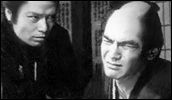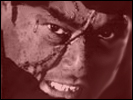The Yakuza’s Law: Lynching!
- Year
- 1969
- Original title
- Yakuza Keibatsushi Rinchi
- Japanese title
- やくざ刑罰史 私刑
- Director
- Cast
- Running time
- 60 minutes
- Published
- 14 November 2001


by Jasper Sharp
The Yakuza, the Japanese equivalent of the Mafia, have been one of the mainstays of the national film industry for almost as long as it has been in existence, though the genre really snowballed throughout the course of the 1960s, setting in motion a long run of films that ranged from the quirky pop-art experimentations of Seijun Suzuki, the chaotic socio-realism of Kinji Fukasaku, the meditative minimalism of Takeshi Kitano to the slick exercises in cinematic technique of such postmodern directors as Takashi Miike and Takashi Ishii.
Whether portrayed as stoic antiheroes or craven cowards, the yakuza have in any measure acquired a degree of cool glamour as they endlessly battle between the internal dilemmas raised by the honour and duty dichotomy. However, the "did he jump or was he pushed?" mystery surrounding the mysterious death of Tampopo director Juzo Itami in the wake of his kiss-and-tell exposé of mob business practices in The Gentle Art of Japanese Extortion (Minbo no Onna, 1992) does highlight that there's a far darker side to the real-life yakuza than their neatly coiffed hair and meticulous tattoos might suggest.
It's a fact well known to maverick director Teruo Ishii, whose early contribution to the genre in 1961, Hana to Arashi to Gang (which awkwardly translates as Flower, Storm, and Gang) featured the iconic presence of a young Ken Takakura, the man every yakuza dreams of being one day reincarnated as, and brought a thoroughly contemporary take to the genre, setting in motion an 11-part series in the process.
Ishii also knows a lot about sadistic violence as well, kick-starting his trademark cycle of gruelling torture films in 1968 with Shogun's Joy of Torture (Tokugawa Onna Keibatsushi), which he followed up rapidly with another 6 films within the space of the next two years. The majority of these films focus on nubile young women being punished for their transgressions against the social order of the day. With the seventh in the series however, The Yakuza's Law: Lynching!, the director returned to the all-male mobster milieu once more to deliver one of the most graphically gruesome of the series.
To all intents and purposes, Yakuza's Law doesn't deviate too far from the template developed in the director's preceding torture films. Beginning with a portentous opening quote ("The Yakuza are a group of men who are bound by iron rules") against a flaming backdrop, the credits roll over a grisly montage of torture scenes, featuring such inventive demises as a power drill through the top of the head, an eyeball singed from its socket by a magnifying glass, and an ignominious lingering death by a human rotisserie, all set against a soundtrack that sounds like it was borrowed from an Italian crime thriller of the same period. If you can make it past the credits, you can relax a bit as Ishii settles into his usual three-story portmanteau approach and limits himself to firstly detailing the reasons for each section's atrocities, all delivered in a trademark deadpan style: a violation of a particular 'Yakuza Law' culminating in a climactic torture session, the 'Lynching'.
In the first part, set in the Edo period, the particular law is "One should not steal, and one should not have affairs with married women", violation of which leads to more than just a severed pinkie. Poor Tomoso, put in charge of the mob's gambling house after his impressive showing in a pitched battle against a rival gang, manages to breach both codes, leading to a gruelling punishment for him and his associates as a tongue is torn out, an ear cut from the head, and an eye plucked out with a knife. Grim.
A slightly more sedate second segment begins with the precept "Those who cause trouble for the boss and the family will be expelled. Those who return will be punished." The 1920s, and Shuji Ogata is just released from jail having served three years of his life for a mob who won't even dignify his sacrifice by sending someone to meet him at the gates. He immediately takes it out on the boss of the rival Koda gang, an act which rekindles a long-standing territorial dispute between them and his own syndicate. He is subsequently expelled from the region, but returns to pick up his girlfriend, an act that culminates in an orgy of bloodshed. Aside from a few gruesome setpieces, this one is actually mercifully short of torture.
As with Shogun's Joy of Torture, the third segment, "Those who destroy the family organisation, and those leaking secrets for whatever reason, will be eliminated" is the most substantial, in terms of length at least. Set in contemporary Tokyo, where swords make way for handguns, this final segment bears a superficial resemblance to Fukasaku's yakuza films of the early 70s (Battles Without Honour and Humanity et al.). A theft from the safe of the Hashiba family sets in effect a string of related revenge killings, as numerous errant gangsters are dragged behind helicopters and deposited from a great height into the ocean, are compacted along with their cars into cubic meters of solid steel or have their faces seared off by cigarette lighters.
Given the inherent limitations of these films, the fact that they were produced by Toei allows Ishii's torture cycle to benefit from the resources available from such a large studio: sets, costumes, and name actors such as Bunta Sugawara were provided in-house and all lend high production gloss to the proceedings. Yakuza Law: Lynching also manages to overturn the charges of misogyny that the rest of the cycle are laid so open to from today's audiences. Aside from a gangster's moll getting slapped about before donning the customary concrete overcoat and being deposited at the bottom of the ocean, all of the tortures here are inflicted by males upon males.